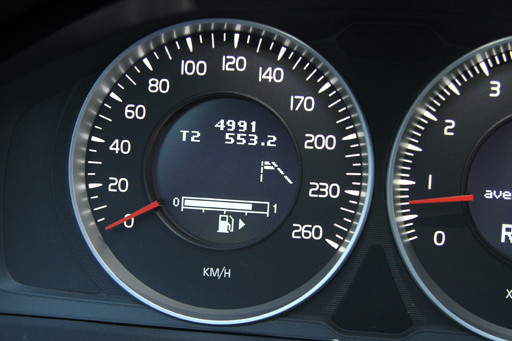It’s Over There
You’re on vacation, driving somewhere in your rental car. Maybe you’re off to the beach. But then, you realize you have a problem. As seen above, you’re out of gas.
No big deal — it’s 2015, so there’s a pretty good chance the car has a GPS or, at least, that your phone has an app which can handle the task. You ask it to direct you to a nearby gas station and you’re there in no time, maybe with a gallon to spare. You pull into the station and you realize there’s a new problem:
You don’t know which side the gas tank is on.
For some reason, the gas cap placement on cars isn’t standardized — some are on the driver’s side while others are on the passenger’s side. (It used to be common for the gas tank opening to be in the front of the car, but for now-obvious safety reasons, that was discontinued decades ago.) Yes, you have a 50/50 chance, and worst-case scenario, you end up getting out of the car, seeing your mistake, and pulling around the other way. Not a big deal, especially if you’re on vacation and the weather is (hopefully) nice. But there’s no need to guess. The answer, in the picture above at least, is right in front of you.
If you look at the fuel gauge, near the “F,” you’ll see a small image of a gas pump. To the left of that pump is an arrow, pointing left. That’s not just a decoration nor is it an accident. That arrow points to the side that your gas tank is on. Here’s another example, pointing right:

According to Slate, this feature — which Slate’s back-of-envelope survey suggests few people know about — is standard on the “vast majority” of new cars. It’s unclear when this became a regular feature but you’ll be hard pressed to find a car which doesn’t have it, today. (There are some reports that MINI doesn’t do this, and while a Google Image Search shows some without the arrow, there are other results, like this one, which contain the indicator.) A rumor circulated for a while that on older cars — those without the arrow — the handle of the gas pump icon served the same purpose; if the handle was on the right, so was the gas tank, and vice versa. But according to Allstate, that isn’t by design: “sometimes there is a correlation between the pump handle and the gas cap location, but it appears to be simply coincidence.”
In any event, the arrow has made the rumor moot; it’s just that a lot of people don’t know about it. The feature isn’t a secret, of course — it’s almost certainly in your user manual. But who reads those?
 Bonus Fact: According to the U.S. Environmental Protection Agency, you shouldn’t top off your gas tank — you may end up costing yourself money in the end. The EPA explains: “The gas nozzle automatically clicks off when your gas tank is full. In areas of ozone nonattainment, gas station pumps are equipped with vapor recovery systems that feed back gas vapors into their tanks to prevent vapors from escaping into the air and contributing to air pollution. Any additional gas you try to pump into your tank may be drawn into the vapor line and fed back into the station’s storage tanks.”
Bonus Fact: According to the U.S. Environmental Protection Agency, you shouldn’t top off your gas tank — you may end up costing yourself money in the end. The EPA explains: “The gas nozzle automatically clicks off when your gas tank is full. In areas of ozone nonattainment, gas station pumps are equipped with vapor recovery systems that feed back gas vapors into their tanks to prevent vapors from escaping into the air and contributing to air pollution. Any additional gas you try to pump into your tank may be drawn into the vapor line and fed back into the station’s storage tanks.”
From the Archives: It’s a Gas: It has nothing to do with the above, except for the title (which I wanted to use for today’s).
Related: “The Machine That Changed the World: The Story of Lean Production– Toyota’s Secret Weapon in the Global Car Wars That Is Now Revolutionizing World Industry.” It has a really long title but the 103 reviews averaging out to 4.4 stars suggests that it is, otherwise, pretty good.

